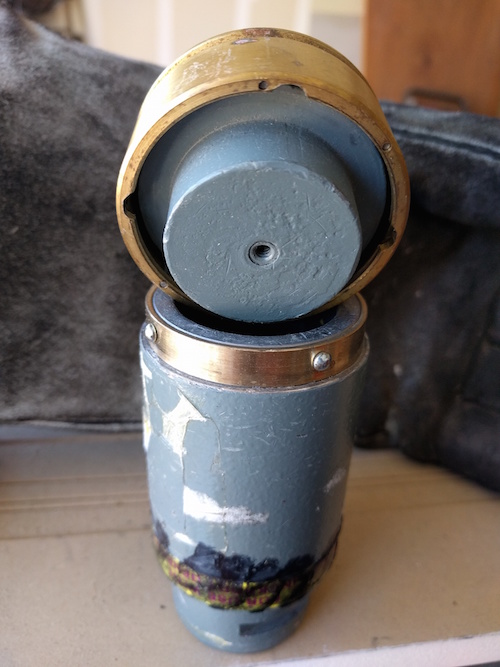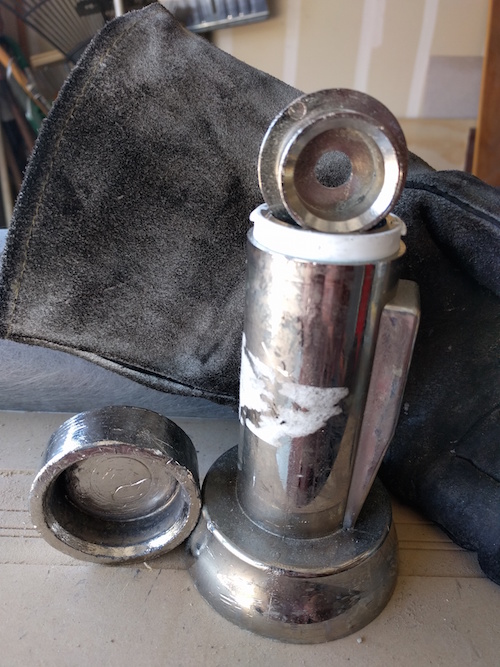- Introduction
- Bevel
- Small Blue Vial
- Lead Bucket
- Core
- Core Plug
- Grey Cube
- Medium Cylinder
- Stubby Container
- Large Capacity Cylinder
- Small Capacity Cylinder
- White Cylinder
- Yellow Cylinder
- Purple Cylinder
- White Cylinder 2
- Grey Cylinder
- Fat Vial
- Brass Cap Grey Cylinder
- The Apparatus
General Information
Isotope lead, or more accurately nuclear medicine radiation shielding, is a great source of lead for bullet casting. This page documents the various castings I have encountered in the 50,000+ lbs. of this type of lead I have dealt with.The majority of this lead is very similar in hardness to wheel weight lead. However, about 12% is very soft lead. The two types are easily distinguished once you have handled both. If you only have a small sample that is all the same, drop a vial on the floor. The soft lead will thud, while the alloy with have a ring, to go with the thud.
Radiation Hazard
There has been some concern regarding radiation hazard from this lead. The lead generated by the pharmaceutical industry is used to house a variety of isotopes. The longest lived of the common isotopes has an 8 day half-life. The shortest is 13 seconds!Once removed from service, the lead is decayed until two seperate gieger counters register only background radiation at their highest setting. This will take as long as 2 months. If you are concerned about radiation, decay it yourself for 60 days after you get it.
Refining Method
While each caster must develop his own protocols for generating ingots ready for the casting pot, I will detail briefly the method I employ.I use a Camp Chef propane burner as a heat source, and a cheap 5 qt. dutch oven as a refining vessel. Wear a long sleeve shirt, jeans, welders gloves and safety glasses. Refine pure lead and alloys seperately.
Start with a lead bucket filled with a random assortment of alloyed vials, for a total weight of about 30 lbs. Heat the dutch oven with five or six small vial tops, or two or three thin walled vials. Once these melt, add the rest of the assorted lead and lid the pot for five minutes.
The lead bucket and lid are added to the melted assorted lead. Add carefully, as this will float until the bottom melts through. Once the bottom melts though, I add two core stoppers, cover with the lid, and let heat for 5 minutes. The latex paint is quite smokey.
Once the bucket is melted, stir in a handful of sawdust and about 4 oz. of used motor oil. Apply a match to ignite, and let it burn out. Skim the residue from the surface and discard. Carefully add a core to this mixture and cover the pot with the lid for 10 minutes.
After 10 minutes, the core is usually melted. Skim out the two brass knurled nuts, and lightly flux with bees wax if needed. Cast 30 lbs. of ingots, then add a second core and melt. Cast another 30 lbs. of ingots, then repeat the process above for another bucket and assorted vials.
Repeat this until you or the lead run out. Using two burners and dutch ovens can minimize downtime by having one pot melting while you cast from the other.
Bullets and Hardness
Below is some data on the average brinell hardness numbers of this lead. This data was generated by the experiments my son conducted for his science fair project. He measured hardness of the result samples when cast at different temperatures and given different heat treatments.The samples were cast using a Lee 175 gr. .401 SWC TL bullet mold. Each series consisted of 30 casts, with 10 selected at random for testing. Quenched indicates if the sample was air cooled or water dropped from the mold. Heat treatmenst were: None, no heat treating post casting (except for possible quenching from the mold). Low, samples were heated to 350° for one hour, and allowed to air cool. High, samples were heated to 450° for one hour and quenched.
The data indicates what is expected. The more energetic the lead at the moment of quenching, the greater the effect of the treatment. I am sure the average brinell number acheived in series 14 only from quenching could be duplicated with any sample by heat treating the sample closer to the melting point. Though not included on this table, uniformity of hardness was better when the samples were treated in the oven, rather than quenched.
| Series | Casting Temp | Quenched | Average BHN | Average Weight | Heat Treatment | BHN Avg@24Mon |
|---|---|---|---|---|---|---|
| 1 | 650 | No | 10.53 | 172.08 | None | 13.94 |
| 2 | 650 | Yes | 25.88 | 172.43 | None | 23.77 |
| 3 | 650 | No | 10.83 | 172.59 | low | 12.16 |
| 4 | 650 | No | 16.44 | 172.08 | high | 21.16 |
| 5 | 650 | Yes | 10.67 | 172.71 | low | 12.96 |
| 6 | 650 | Yes | 17.38 | 172.79 | high | 22.11 |
| 7 | 700 | No | 11.23 | 173 | None | 16.73 |
| 8 | 700 | Yes | 29.5 | 172.93 | None | 24.29 |
| 9 | 700 | No | 9.72 | 173.06 | low | 11.79 |
| 10 | 700 | No | 20.46 | 172.74 | high | 23.26 |
| 11 | 700 | Yes | 10.13 | 172.62 | low | 12.92 |
| 12 | 700 | Yes | 21.83 | 173.03 | high | 23.81 |
| 13 | 750 | No | 11.77 | 173.22 | None | 17.74 |
| 14 | 750 | Yes | 32.41 | 173.55 | None | 24.64 |
| 15 | 750 | No | 9.86 | 172.88 | low | 12.42 |
| 16 | 750 | No | 24.87 | 173.24 | high | 23.39 |
| 17 | 750 | Yes | 10.37 | 173.37 | low | 12.64 |
| 18 | 750 | Yes | 25.33 | 173.66 | high | 24.1 |
Conclusion
Hopefully you will find this information useful in casting some quality bullets using isotope lead.| Weight: 20 oz. height: 3" Diameter: 1.5" Hardness: 10.5 BHN Melting Point: ≈550° Alloyed lead. This container is noted by the bevels on the base and lid. No paint is present, although foam padding may be present inside the vial. |
| Weight: 5.8 oz. height: 2.375" Diameter: .875" Hardness: 10.5 BHN Melting Point: ≈550° Alloyed lead. These containers are the smallest I have encountered. The paint is very thin and will flake off. Light fluxing is required to remove impurities caused by the paint |
| Weight: 15.5 lbs. height: 6.25" Diameter: 5.75" Hardness: 10.5 BHN Melting Point: ≈550° Alloyed lead. The lead bucket and lid have a heavy latex paint. They are best handled in a pot already containing 10 lbs. or more of melted lead. Flux and flame (I prefer used motor oil and sawdust) to reduce the paint to an ash for easy removal. Styrofoam glued to the lids will scrape off with a knife prior to refining. |
| Weight: 31.5 lbs. height: 6.625" Diameter: 5" Hardness: 10.5 BHN Melting Point: ≈550° Alloyed lead. Great to work with. Occasionally, spots of much harder lead can be identified, although, they can't readily be removed for seperate processing. Ideally, add to 20-30 lbs. of 700° lead that is fluxed already. Two small brass knurled nuts must be removed after melting. Lots of yield from one item. Flux only needed for oxidation of metals. |
| Weight: 26 oz. Dimensions: 3"X3.5"X1.5" Hardness: 12.5 BHN Melting Point: ≈550° Alloyed lead. These tend to be harder than the rest of the lead. The paint is very thin, but well adhered. Light fluxing needed to remove the paint residue. |
| Weight: 23.5 lbs. Dimensions: 5.5"X3.5"X3.5" Hardness: 5 BHN Melting Point: ≈620° Along with the purple and blue iodine containers, these are soft lead. Not painted on bottom. Paint will flake off. As with all pure or near pure lead, more energy is required to melt this container. |
| Weight: 19.5 oz. height: 3" Diameter: 1.5" Hardness: 10.5 BHN Melting Point: ≈550° Alloyed lead. This unpainted cylinder melts easily and requires minimal flux to clean. |
| Weight: 11 oz. height: 2.625" Diameter: 1.5" Hardness: 10.5 BHN Melting Point: ≈550° Alloyed lead. Distinguished by rounded corners on the top and bottom, this container is also unpainted. Minimal flux and easy to melt. |
| Weight: 11.5 oz. height: 3.125" Diameter: 1.25" Hardness: 10.5 BHN Melting Point: ≈550° Alloyed lead. Thin walled, these containers melt fast and require little flux. |
| Weight: 22.5 oz. height: 3.25" Diameter: 1.25" Hardness: 10.5 BHN Melting Point: ≈550° Alloyed lead. These containers have thick walls. While they melt at the same temperature as the other alloys, they take longer to melt becuase of the extra mass. |
| Weight: 11.5 lbs. height: 4.5" Diameter: 3" Hardness: 10.5 BHN Melting Point: ≈550° Alloyed lead. These appeared only in my most recent acquisition. The paint will require additional flux to refine the melt. Large size will melt slower than the smaller items. |
| Weight: 36.5 oz. height: 3.75" Diameter: 1.75" Hardness: 10.5 BHN Melting Point: ≈550° Alloyed lead. Also new in the most recent batch, I have only seen this one. Paint will dictate some fluxing to remove impurities. |
| Weight: 201.4 oz. height: 5.375" Diameter: 3.25" Hardness: 5 BHN Melting Point: ≈627° Pure lead. Generally has goo around the to from the velcro they use to keep the top on. Smelly and smokey to refine. |
| Weight: 53.2 oz. height: 3.5" Diameter: 2.25" Hardness: 10 BHN Melting Point: ≈550° Alloyed lead. Yttrium-90 container. Paint makes it smelly to refine. |
| Weight: 33.1 oz. height: 3.25" Diameter: 1.75" Hardness: 10 BHN Melting Point: ≈550° Alloyed lead. Relatively clean. Lids have a green lacquer of some kind. |
| Weight: 40.2 oz. height: 3.25" Diameter: 2.00" Hardness: 10 BHN Melting Point: ≈550° Alloyed lead. Hot melt glue usually left on bottom. |
 |
Weight: 48.0 oz. height: 4" (ish) Diameter: 1.850" (inner brass ring) Hardness: 8 BHN Melting Point: ≈590° Low alloy lead. Softer alloy than other isotope lead. I thought it was pure but it went "mushy" indicating some tin/antimony. Height is estimated after the fact. I forgot to measure they were melted. |
 |
Weight: 83.0 oz. height: 6" (ish) Diameter: 2"-4" Hardness: 5 BHN/ 8 BHN Melting Point: ≈580°-≈627° Calling this one an "Apparatus". Different parts were different alloys ranging from pure to normal isotope lead. Really curious thing is the bright shiny silver coating. In fact, I thought they were stainless with just some lead inserts until the whole thing melted. |